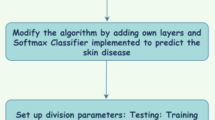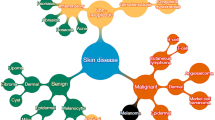Abstract
One of the most common diseases around the globe is dermatological problem. Despite being frequent, its diagnosis is very challenging because of the complexity of its skin tone, colour and hair existence. This research offers a method to automatically forecast the many types of skin illnesses using a variety of computer vision-based approaches (deep learning). With the many skin photos, the system uses deep learning techniques to train itself. One of the main goals of this approach is improving the accuracy with which skin illness can be predicted and vast majority of the population is healthier. The most common causes of skin disorders include allergies, bacteria, mycosis, viruses, etc. The rapid development of medical and laser technologies that are founded on photonics has made it possible to identify skin issues in a manner that is both timely and precise. Such diagnoses can only be made with expensive, specialized medical equipment. As a result, deep learning algorithms help diagnose skin problems before they become severe. The categorization of skin conditions relies heavily on extracting features. Deep learning algorithms have substantially reduced the requirement for labour-intensive manual operations such as data restoration and extraction of features for classifications.
Access this chapter
Tax calculation will be finalised at checkout
Purchases are for personal use only
Similar content being viewed by others
References
Deepalakshmi P, Lavanya K, Srinivasu PN (2021) Plant leaf disease detection using CNN algorithm. Int J Inf Syst Model Des (IJISMD) 12(1):1–21
Anitha J (2018) Identification of melanoma in dermoscopy images using image processing algorithms. In: International conference on control, power, communication and computing technologies (ICCPCCT). IEEE, pp 553–557
Roy K, Chaudhuri SS, Ghosh S, Dutta SK, Chakraborty P, Sarkar R (2019) Skin disease detection based on different segmentation techniques. In: International conference on opto-electronics and applied optics (Optronix). IEEE, pp 1–5
Kotian AL, Deepa K (2017) Detection and classification of skin diseases by image analysis using MATLAB. Int J Emerg Res Manag Technol 6(5):779–784
Sundaramurthy S, Saravanabhavan C, Kshirsagar P (2020) Prediction and Classification of rheumatoid arthritis using ensemble machine learning approaches. In: Proceedings of the 2020 international conference on decision aid sciences and application (DASA). Sakheer, Bahrain, pp 17–21
Skin Disease. https://www.medanta.org/patient-education-blog/everything-about-common-skin-disorders/
Ronneberger O, Fischer P, Brox T (2015) U-net: convolutional networks for biomedical image segmentation. In: International conference on medical image computing and computer-assisted intervention. Springer, Cham, pp 234–241
Yu Z, Jiang X, Zhou F, Qin J, Ni D, Chen S, Wang T (2018) Melanoma recognition in dermoscopy images via aggregated deep convolutional features. IEEE Trans Biomed Eng 66(4):1006–1016
Phillips A, Teo I, Lang J (2019) Segmentation of prognostic tissue structures in cutaneous melanoma using whole slide images. In: Proceedings of the IEEE/CVF conference on computer vision and pattern recognition workshops
Reddy VJ, Nagalakshmi TJ (2019) Skin disease detection using artificial neural network. Indian J Public Health Res Dev 10(11)
Jana E, Subban R, Saraswathi S (2017) Research on skin cancer cell detection using image processing. In: 2017 IEEE international conference on computational intelligence and computing research (ICCIC). IEEE, pp 1–8
Zaqout I (2019) Diagnosis of skin lesions based on dermoscopic images using image processing techniques. Pattern Recognit Sel Methods Appl
Kumar VB, Kumar SS, Saboo V (2016) Dermatological disease detection using image processing and machine learning. In: 2016 Third international conference on artificial intelligence and pattern recognition (AIPR). IEEE, pp 1–6
Khan MA, Javed MY, Sharif M, Saba T, Rehman A (2019) Multi-model deep neural network-based features extraction and optimal selection approach for skin lesion classification. In: 2019 international conference on computer and information sciences (ICCIS). IEEE, pp 1–7
Amarathunga AA, Ellawala EP, Abeysekar GN, Amalraj CR (2015) Expert system for diagnosis of skin diseases. Int J Sci Technol Res 4(01):174–178
Chakraborty S, Mali K, Chatterjee S, Anand S, Basu A, Banerjee S, Bhattacharya A et al (2017) Image based skin disease detection using hybrid neural network coupled bag-of-features. In: 2017 IEEE 8th annual ubiquitous computing, electronics and mobile communication conference (UEMCON). IEEE, pp 242–246
Arifin MS, Kibria MG, Firoze A, Amini MA, Yan H (2012) Dermatological disease diagnosis using color-skin images. In: 2012 international conference on machine learning and cybernetics, vol 5. IEEE, pp 1675–1680
Premaladha J, Sujitha S, Priya ML, Ravichandran KS (2014) A survey on melanoma diagnosis using image processing and soft computing techniques. Res J Inf Technol 6(2):65–80
Manerkar MS, Snekhalatha U, Harsh S, Saxena J, Sarma SP, Anburajan M (2016) Automated skin disease segmentation and classification using multi-class SVM classifier
Barati E, Saraee MH, Mohammadi A, Adibi N, Ahmadzadeh MR (2011) A survey on utilization of data mining approaches for dermatological (skin) diseases prediction. J Sel Areas Health Inform (JSHI) 2(3):1–11
Lopez AR, Giro-i-Nieto X, Burdick J, Marques O (2017) Skin lesion classification from dermoscopic images using deep learning techniques. In: 2017 13th IASTED international conference on biomedical engineering (BioMed). IEEE, pp 49–54
Zhang X, Wang S, Liu J, Tao C (2018) Towards improving diagnosis of skin diseases by combining deep neural network and human knowledge. BMC Med Inform Decis Mak 18(2):69–76
Shi X, Dou Q, Xue C, Qin J, Chen H, Heng PA (2019) An active learning approach for reducing annotation cost in skin lesion analysis. In: International workshop on machine learning in medical imaging. Springer, Cham, pp 628–636
Chatterjee S, Dey D, Munshi S, Gorai S (2019) Extraction of features from cross correlation in space and frequency domains for classification of skin lesions. Biomed Signal Process Control 53:101581
Monisha M, Suresh A, Rashmi MR (2019) Artificial intelligence-based skin classification using GMM. J Med Syst 43(1):1–8
Esteva A, Kuprel B, Novoa RA, Ko J, Swetter SM, Blau HM, Thrun S (2017) Dermatologist-level classification of skin cancer with deep neural networks. Nature 542(7639):115–118
Data Science. https://www.medanta.org/patient-education-blog/everything-about-common-skin-disorders/
Brinker TJ, Hekler A, Utikal JS, Grabe N, Schadendorf D, Klode J, Von Kalle C (2018) Skin cancer classification using convolutional neural networks: systematic review. J Med Internet Res 20(10):e11936
Kulhalli R, Savadikar C, Garware B (2019) A hierarchical approach to skin lesion classification. In: Proceedings of the ACM India joint international conference on data science and management of data. pp 245–250
Author information
Authors and Affiliations
Corresponding author
Editor information
Editors and Affiliations
Rights and permissions
Copyright information
© 2023 The Author(s), under exclusive license to Springer Nature Singapore Pte Ltd.
About this paper
Cite this paper
Goindi, S., Thakur, K., Kapoor, D.S. (2023). Skin Disease Classification and Detection by Deep Learning and Machine Learning Approaches. In: Mishra, A., Gupta, D., Chetty, G. (eds) Advances in IoT and Security with Computational Intelligence. ICAISA 2023. Lecture Notes in Networks and Systems, vol 755. Springer, Singapore. https://doi.org/10.1007/978-981-99-5085-0_16
Download citation
DOI: https://doi.org/10.1007/978-981-99-5085-0_16
Published:
Publisher Name: Springer, Singapore
Print ISBN: 978-981-99-5084-3
Online ISBN: 978-981-99-5085-0
eBook Packages: Intelligent Technologies and RoboticsIntelligent Technologies and Robotics (R0)




